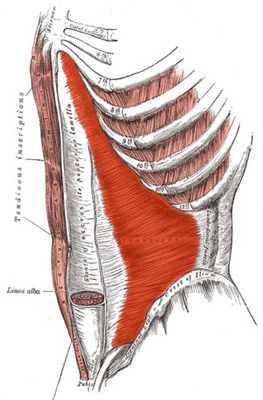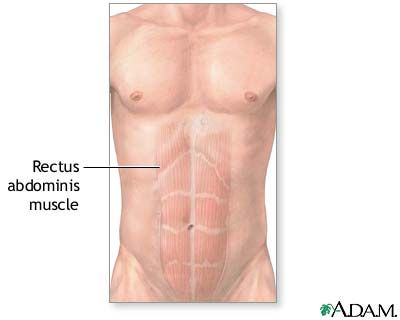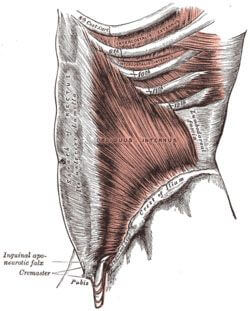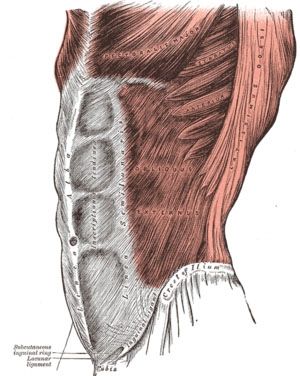An insane number of articles have been written about how to achieve a flat, tight abdominal wall. Some days it almost feels like you could read your way to that perfect six pack.
That said, it’s very curious that the reason most of us fail to achieve those rippling abs is lack of proper knowledge. Understanding abdominal anatomy is a key to achieving that flat, toned tummy.
For example, did you know that if you’re shooting for a six pack, it’s impossible to work up to an eight pack?
The number of “packs” a person can display is a result of the number of bands of fascia (the connective tissue above all your muscles) that crosses the abdominal region. Where the bands of fascia cross the stomach creates those lateral rows we love to see.
Arnold Schwarzenegger, Mr. Olympia himself – showed a four pack his whole career.
In fact, reading Schwarzenegger’s New Encyclopedia of Modern Bodybuilding (download the PDF version here) is what made it possible for me to build my own six pack. Using this helpful resource was like having the lights turned on. All of a sudden, how and why to work the abs made total sense!
Without core knowledge of how the midsection pulls the body together and is used to create killer abs, I might never have had the wherewithal to stick with my routine. But sure enough, a few months after reading that section in the book, I was seeing what I wanted – and I’ve never looked back.
This post is going to give you the full rundown about what’s necessary – and what you can do without – when getting serious about a truly chiselled set of abs.
Forget those lame crunches. It’s time to connect to your real abdominal strength.
Core Strength is #1
The best abs routine is a curated balance between core exercises and abdominal strengthening. The core is a complex series of muscles which extends from your spine and down into your pelvis, running underneath the entire abdominal area.
In reality, each and every exercise is a core exercise – because every movement you do includes your core.
Running? Certainly. Squats? 100% Bench? Every day.
Making sure to keep the core in optimum shape will prevent injuries, enhance range of motion, and enable the best possible exterior physique.
Every core workout activates the abs way more than a regular crunch, giving back greater results, health, and looks – in less time.
To truly bust into your best abdominal shape ever, you’ll need a solid core underneath upon which you can build the best abs.
Your core is made up of three sheaths of muscle:
- Upper abs
- Internal obliques
- The Deep 4: Pelvic Floor, Diaphragm, Multifidus, Transverse Abdominus
When you do a hard-hitting, comprehensive abdominal workout you target each of these three areas. Upper abs, obliques, and transversus abdominis can all be isolated and targeted to produce results. The most underdeveloped, yet most important part of the core, is the transverse abdominus.
The Transverse Abdominus

verywell.com
The transverse abdominus is the horizontal layer of muscle that envelops your six pack area. It wraps around the torso from front to back and from the ribs to the pelvis. As the anatomically deepest abdominal muscle, the transversus abdominus helps with respiration and proper breathing and supports the spine.
Work the transverse abdominus to thin down your waist and enhance the definition across the stomach.
How To: To do this, simply engage your core (not tighten your abs). Pull your belly button towards your spine, keep breathing normally, and create a vacuum in your stomach. By keeping the transverse abdominus tight and engaged you support the spine. Before abdominal exercises, or any strength training, be sure to create this rock solid area. Not only will it actively build muscle but it will improve the quality of every other exercise you do.
When crafting a tight, flat midsection you must balance and account for all the muscles at work. Most importantly:
- Rectus Abdominus
- Obliques (internal and external)
- Transverse Abdominus
Up next, we take a look at each muscle group, and show you a perfectly balanced core-centric abdominal shredding workout to get a washboard stomach. With only five simple exercises.
Exercise #1 — Captain’s Chair Knee Raise
Perfectly straight posture is super important here. With shoulders back and back straight, raise your knees up past your waistline, then slowly lower the legs back to straight. If you don’t raise your hips high enough, the hip flexors will end doing all the work. Get this movement right and you’ll be stimulating the abs up to 200 percent more than with the laydown, crunching motion.
These knee raises will help you target the hard-to-work lower abs at the waistline.
2 – 3 sets, 15 – 20 reps
If these are easy, do straight leg raises and maybe alternate legs. Hold a dumbbell between your legs for additional resistance. However you do them, be sure not to swing your legs or jerk your hips. For extra burn, see if you can raise your heels above your head.
This exercise is great for targeting the rectus abdominus, those front-and-center muscles of the abdominal region.
If you ever hear people talking about training the upper or lower abs, both refer to the rectus abdominus. The only difference is which specific area of the muscle is being targeted. While the lower abs are considered harder to train, this due mainly to an imbalance in core strength and range of motion around the lower abdomen. By improving dynamic movement with core exercise and cardio, expect lower flab to disappear.

This is what we think of when we think of the six pack: the long, flat musculature in that runs down our stomach. Where this muscle crosses the transverse abdominus and it’s fascia, the abs are made distinct and visible.
These two paired sheets of muscle connect under the ribs and down to the pelvis, allowing you to flex forward and pull your knees to and from the torso.
Exercise #2 — Plank
The plank is the best overall core workout you can get, and it can stimulate up to 130 percent more ab action than a crunch. The plank will target the whole set of your obliques, the rectus abdominis, and strengthen the lower back. Plus, you can do it anywhere.
Make sure to keep your arms straight, your elbows hugged into your sides, and your back straight.
2 – 3 Sets, 30 – 60 second holds
To take the plank to the next level, widen your feet and reach your hands forward. If you do this, be sure not to tilt from the hips but to keep them locked. Feeling like a bit more? Bring your knees up towards your elbows for a spider plank movement. This will really hit those side obliques.

Internal Obliques

verywell.com
External obliques
Inside the abdominal area, there are two oblique muscles: the internal and the external. The external obliques are the V-shaped column of muscles that run diagonally down your sides, connecting to your pelvis. Also called the inguinal curve, this is second only to the six pack area in terms of desirability.
Before you engage in plate twists, side raises, or barbell twists (for the external obliques) be sure to show your internal obliques love. These sit beneath the external obliques, and are involved in flexing the spine, sideways bending, rotating the torso, and compressing the abdomen.
Exercise #3 — Side Plank
The side plank targets each side of the body and allows you to see where you’re weak and need to improve on imbalances. Side planks hit the abductors, adductors, quads, hamstrings, glutes, shoulders, and low back – so these are terrific all-over workout.
2 – 3 Sets, 30 – 60 second holds on each side
Look forward while keeping the shoulder, hip, and ankle in line. The neck should be in line with the spine and the chin should be off the chest.
To challenge yourself, raise the top leg off the ground. This will hit those obliques nicely.
Or maybe grab dumbell for a “sweep.” Bring the weight from under your torso, over your head in an arch, and back down again in controlled fashion.
Exercise #4 — Bicycle Crunch
Bicycle crunches can stimulate up to 190 percent more activity than regular crunches. Most importantly, fully extend one leg at a time while bringing the shoulder (not the elbow) up to touch your opposite knee. These are best done slowly, which will allow you to visualize the contraction. The side to side movement will hit the obliques, the rectus abdominis, and lower abs.
2 – 3 Sets, 15 – 20 reps
Exercise #5 — Reverse Crunch
Lay your hands flat beneath your butt and bring your knees up to your chest. Lower your legs down in the same motion, going especially slowly when feet near the ground (feel the burn in the lower abs). Keep your focus upon your pelvis as you tuck upwards. The lower abs will really start to activate as you roll your pelvis up and forward. This exercise, when done correctly with proper concentration, will active the abs 140 percent more than a typical crunch.
Introduce a slight twist as your feet approach the ground – this will bring the obliques in for a good bit of work.
2 -3 sets, 15 – 20 reps
Be Kind to Your Hip Flexors
The hip flexors are a group of muscles that bring the legs and trunk together in a flexion movement.
Many exercises that are promoted as abdominal workouts end up working the hip flexors more than abs. Many of us have very tight hip flexors (sitting doesn’t help any) and so avoiding excess stress on this area is important to a healthy, sports-performance body.
The hip flexors are very powerful and can often overtake the abdominal muscles in certain exercises. To minimize this unwanted involvement, keep the abdominals fully contracted.
An example of this is sit-ups with the feet held down. This is primarily a hip flexor movement and will cause the low back to arch – leading to risk of back pain, especially if you’ve got weak abdominal muscles. For this reason, this full sit up is not recommended for beginners.
Another exercises that’s heavily reliant on hip flexors is any leg-raising exercise done while lying in a face up position. Without strong abs, this is just a hip flexor exercise and should be avoided until abs are very developed.
Again: the best way to isolate the abs is in minimizing the work of the hip flexors.
Build Your Own Custom Ab Workout
Because the abs are comprised of four major different muscle groups, balancing your approach will always be key. If you feel like taking a step outside of this core exercise routine provided, build your own routine, or add a few other exercises to spice up or focus on underdeveloped areas.
Instead of concentrating on certain muscle groups, keeping the focus upon the range of motion will provide the functional balance in the body. Select 5 – 10 exercises in combination:
Spinal flexion:
Rotation:
Extension:
Stability:
Burn Fat to Target the Abs
Whether or not they’re muscularly defined underneath, if you’re having a hard time seeing your abs it’s because of fat deposits around the abdomen. Aside from a rigorous abdominal routine, there are a couple other areas of total body fitness you can address to get the most from your midsection.
Weightlifting
A regular routine of weightlifting will have your body burning more fat and will also increase your metabolism. When large muscles undergo repeated stress over extended periods of time, the body reacts by giving them their favorite source of energy for such situations: fat. Whether you’re a guy or gal your abs will directly benefit from weight lifting. Not only does strength training boost your body’s overall reliance upon fat as an energy source, but it will engage your core and abdominal muscles through a wide range of exercise. Talk about double duty!
A Better Diet
Abs are made in the kitchen. Too much fat and all your hard work won’t mean a thing.
Newsflash: your body needs healthy fat to operate properly. Go for nuts, olive and coconut oils, avocados, and fish to boost your omega 3 and 6 intakes. These are all examples of monosaturated fats that will actually help your body metabolize belly fat.
But skip hydrogenated oils and trans fats from fast food, processed deli meats, mayonnaise, fried breads, etc. These ingredients have been shown to pack on body fat, particularly around the abdomen.
Sugar becomes belly fat if you eat too much of it. How much is too much for one day? Less than one soda’s worth. 150 calories for men, 100 calories for women.
Keep your eyes peeled for “low fat” options. Most of these offerings have had their natural fats, which may not be bad, replaced with unhealthy doses of sugar to replace taste and mouth-feel. Limiting condiments and dressings – also another source of added sugars – can reduce the fat-to-sugar intake. Breads and pastas are quickly turned into glucose and then into sugar when they hit the bloodstream, so keep them to a minimum to maximize your six pack.
Takeaway
When it comes to achieving rock-hard abs you have to work the right muscles, the core muscles. Only with a balanced, solid base strength in place are other abdominal exercises worth your time. Making core work the cornerstone your abs routine will provide that chiselled look while building a healthy body ready for the long haul. And only when you give your body good food will you see the results for all your hard work. With the knowledge comes the power, and with the repetition come the results!


